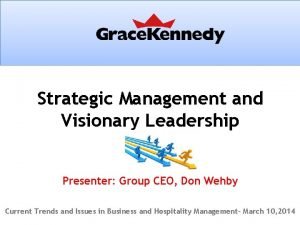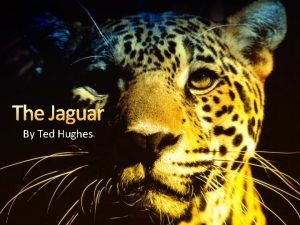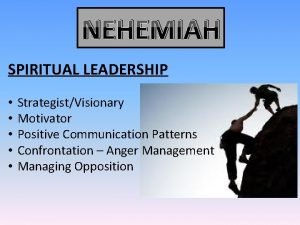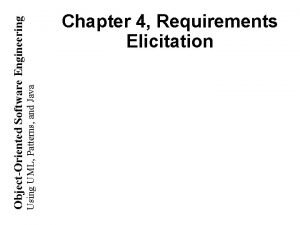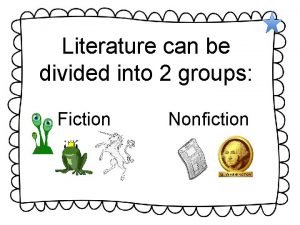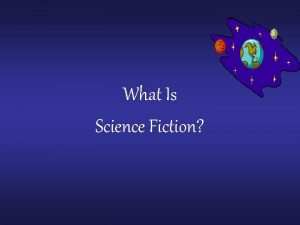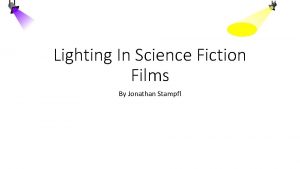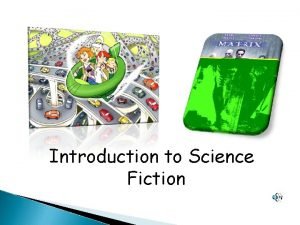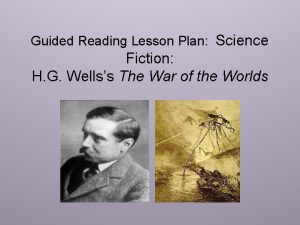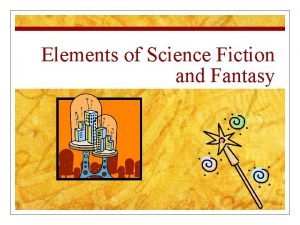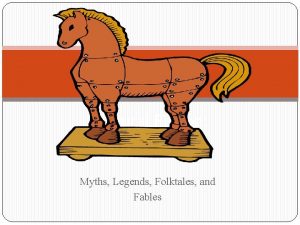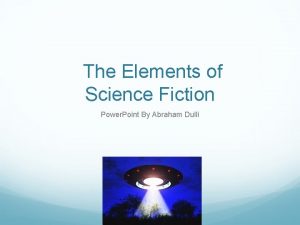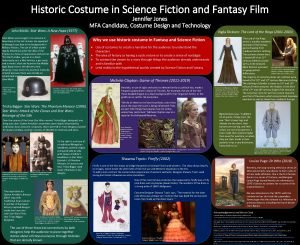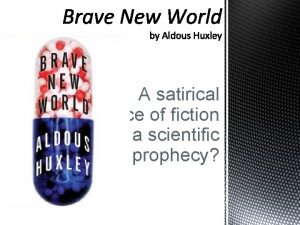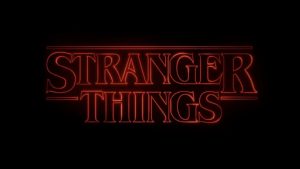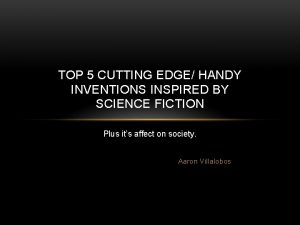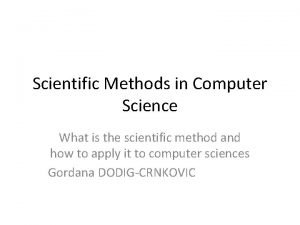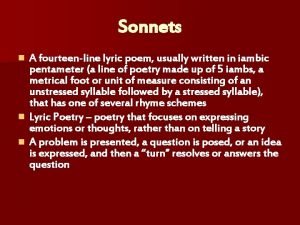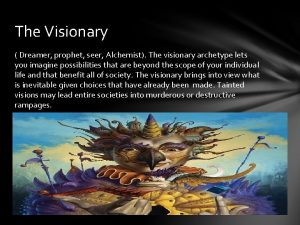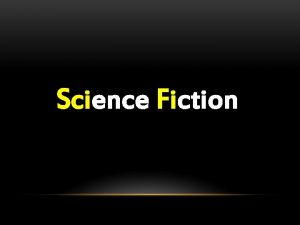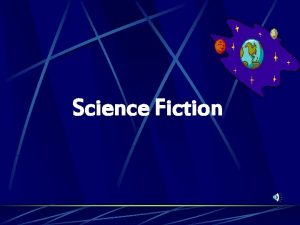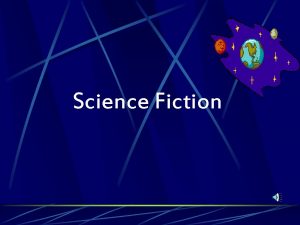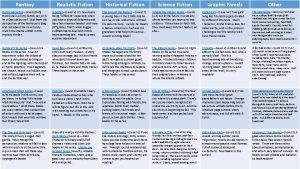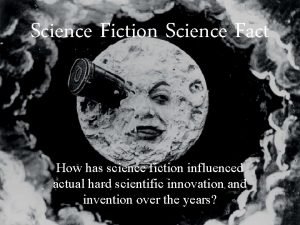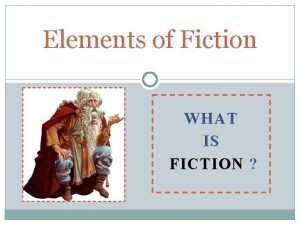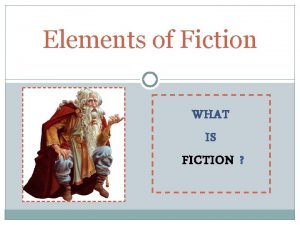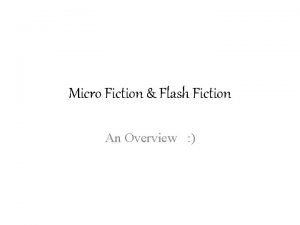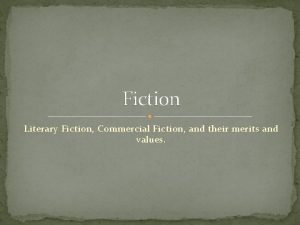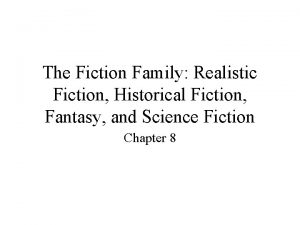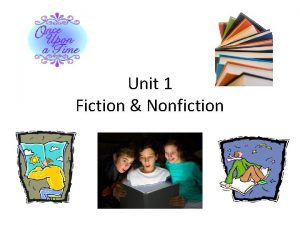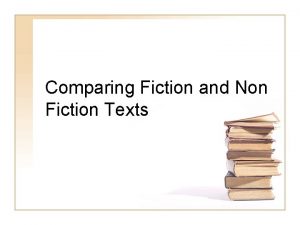SCIENCE FICTION SCIENCE FICTION are usually scientific visionary



















































- Slides: 51


SCIENCE FICTION

SCIENCE FICTION are usually scientific, visionary, comic-strip -like, and imaginative, and usually visualized through fanciful, imaginative settings, expert film production design, advanced technology gadgets (i. e. , robots and spaceships), scientific developments, or by fantastic special effects

SCIENCE FICTION Sci-fi films are complete with heroes, distant planets, impossible quests, improbable settings, fantastic places, great dark and shadowy villains, futuristic technology and gizmos, and unknown and inexplicable forces

SCIENCE FICTION Many other SF films feature time travels or fantastic journeys, and are set either on Earth, into outer space, or (most often) into the future time. Quite a few examples of science-fiction cinema owe their origins to writers Jules Verne and H. G. Wells

SCIENCE FICTION They often portray the dangerous and sinister nature of knowledge ('there are some things Man is not meant to know') The Fly (1986) Vital issues about the nature of mankind and our place in the whole scheme of things, including the threatening, existential loss of personal individuality Invasion of the Body Snatchers (1956)

SCIENCE FICTION PLOTS Space-related conspiracies Supercomputers threatening impregnation The results of germ-warfare and laboratory-bred viruses or plagues Black-hole exploration Futuristic genetic engineering and cloning Strange and extraordinary microscopic organisms or giant, mutant monsters may be unleashed, either created by misguided mad scientists or by nuclear havoc These examples show the tremendous range that science fiction can delve into

SCIENCE FICTION Sci-fi tales have a prophetic nature (they often attempt to figure out or depict the future) and are often set in a speculative future time They may provide a grim outlook, portraying a dystopic view of the world that appears grim, decayed and un-nerving Metropolis (1927) with its underground slave population and view of the effects of industrialization the portrayal of 'Big Brother' society in 1984 (1956 and 1984) Commonly, sci-fi films express society's anxiety about technology and how to forecast and control the impact of technological and environmental change on contemporary society

SCIENCE FICTION Science fiction often expresses the potential of technology to destroy humankind through Armaggedon-like events, wars between worlds, Earthimperiling encounters or disasters (i. e. , The Day The Earth Stood Still (1951), When Worlds Collide (1951), The War of the Worlds (1953)

SCIENCE FICTION In many science-fiction tales, aliens, creatures, or beings (sometimes from our deep subconscious, sometimes in space or in other dimensions) are unearthed and take the mythical fight to new metaphoric dimensions or planes, depicting an eternal struggle or battle (good vs. evil) that is played out by recognizable archetypes and warriors (i. e. , Forbidden Planet (1956), the space opera Star Wars (1977) with knights and a princess with her galaxy's kingdom to save Beginning in the 80 s, science fiction began to be feverishly populated by noirish, cyberpunk films, with characters including cyber-warriors, hackers, virtual reality dreamers and druggies, and underworld lowlifers in nightmarish, un-real worlds i. e. , Blade Runner (1982), Strange Days (1995), Johnny Mnemonic (1995), and The Matrix (1999).

Hybrid Genre Blending and Borrowing The genre is predominantly a version of fantasy films Star Wars (1977), but can easily overlap with horror films, particularly when technology or alien life forms become malevolent Alien (1979) in a confined spaceship (much like a haunted-house story).

Hybrid Genre Blending and Borrowing There are many examples of blurred or hybrid science fiction films that share characteristics with lots of other genres including: • westerns Outland (1980) • romances Somewhere in Time (1980) • adventure films The Thing From Another World (1951) • action films Terminator 2 - Judgment Day (1991) • comedies Sleeper (1973) • serials Star Wars (1977) • cop-buddy films Alien Nation (1988)

The Earliest Science Fiction Films The pioneering science fiction film, a 14 -minute groundbreaking masterpiece with 30 separate tableaus (scenes), Le Voyage Dans La Lune (A Trip to the Moon) (1902), was made by imaginative, turn-of-the-century French filmmaker/magician Georges Melies, approximating the contents of the novels by Jules Verne (From the Earth to the Moon) and H. G. Wells (First Men in the Moon). With innovative, illusionary cinematic techniques (trick photography with superimposed images, dissolves and cuts), he depicted many memorable, whimsical old-fashioned images

The Earliest Science Fiction Films The first science fiction feature films appeared in the 1920 s after the Great War, showing increasing doubts about the destructive effects of technology gone mad. One of the greatest and most innovative films ever made was a silent film set in the year 2000, German director Fritz Lang's classic, expressionistic, techno-fantasy masterpiece Metropolis (1927) - sometimes considered the Blade Runner of its time

The Earliest Science Fiction Films It featured an evil scientist/magician named Rotwang, a sociallycontrolled futuristic city, a beautiful but sinister female robot named Maria (probably the first robot in a feature film, and later providing the inspiration for George Lucas' C 3 PO in Star Wars, a stratified society, and an oppressed enslaved race of underground industrial workers. Even today, the film is acclaimed for its original, futuristic sets, mechanized society themes and a gigantic subterranean flood - it appeared to accurately project the nature of society in the year 2000. [It was re-released in 1984 with a stirring, hard-rock score featuring songs by Pat Benatar and Queen. ]

The Earliest Science Fiction Films Metropolis Trailer

Early Science-Fiction - Horror Film Blends: The 30 s The most memorable blending of science fiction and horror was in Universal Studios' mad scientist-doctor/monster masterpiece from director James Whale, Frankenstein (1931), an adaptation of Mary Shelley's novel. Her original 1818 book was subtitled Frankenstein - The Modern Prometheus

Early Science-Fiction - Horror Film Blends: The 30 s This was soon followed by Whale's superior sequel Bride of Frankenstein (1935), one of the best examples of the horror-SF crossover, and one of the first films with a mad scientist's creation of miniaturized human beings. The famed director also made the film version of an H. G. Wells novel The Invisible Man (1933) with Claude Rains (in his film debut in the starring title role) - it was the classic tale of a scientist with a formula for invisibility accompanied by spectacular special effects and photographic tricks.

Escapist Serials of the 30 s: Flash Gordon & Buck Rogers In the 1930 s, the most popular films were the low-budget, less -serious, space exploration tales portrayed in the popular, cliffhanger Saturday matinee serials with the first two sciencefiction heroes - Flash Gordon and Buck Rogers Space-explorer hero Flash Gordon was a fanciful adventure character derived from the Alex Raymond comic strip first published in 1934 (from King Features). The serials 'invented' many familiar technological marvels: anti-gravity belts, laser/ray guns, and spaceships. Popular elements in the swashbuckling films were the perfectly-cast, epic hero athlete/actor Larry "Buster" Crabbe, the lovely heroine and Flash's blonde sweetheart Dale Arden (Jean Rogers), Dr. Hans Zarkov (Frank Shannon), and the malevolent, tyrant Emperor Ming the Merciless (Charles Middleton) on far-off planet Mongo

The Golden Age of Science Fiction Films In response to a growing interest in rocketry and space exploration, feature-length space travel films gained popularity in the early 1950 s, pioneered by two 1950 films: Rocketship X-M (1950) Destination Moon (1950). The technicolor science fiction film was historically important - it 'invented' the realistic look of spacesuits, rocketships (skillfully-produced models), and the lunar surface. It was an Academy Award winner

Alien Invader Films in the Cold War Era ® Many other sci-fi films of the 1950 s portrayed the human race as victimized and at the mercy of mysterious, hostile, and unfriendly forces ® Cold War politics undoubtedly contributed to suspicion, anxiety, and paranoia of anything "other" - or "un-American. " Allegorical science fiction films reflected the collective unconscious and often cynically commented upon political powers, threats and evils that surrounded us (alien forces were often a metaphor for Communism), and the dangers of aliens taking over our minds and territory.

US films about space invaders in the 50 s included: ® The Day The Earth Stood Still (1951), was a counterrevolutionary film about the madness of Cold War politics; it had an antinuclear war message and ultimatum ("Klaatu barada nikto") brought to Washington D. C. by a gentle, benevolent, and philanthropic Christ-like alien/emissary named Klaatu ® The entire film was a precursor to Spielberg's Close Encounters of the Third Kind (1977) and E. T. : The Extra-Terrestrial (1982)

US films about space invaders in the 50 s included: ® The film noirish science fiction classic, Universal's 3 -D widescreen It Came From Outer Space (1953) with stereo sound ® It was an anticonformist, anti. Mc. Carthy message in its unique tale of benign aliens that crash-landed on Earth in the Arizona desert near a small town

US films about space invaders in the 50 s included: ® The definitive Martian alieninvasion film, copied repeatedly afterwards, was producer George Pal's and director Byron Haskin's film version of H. G. Wells' 1898 story The War of the Worlds (1953) ® Aliens invaded in manta ray-like space ships with cobra-like probes and zapped objects with green disintegration rays to destroy 1950 s Los Angeles ® Remade as a spectacular Steven Spielberg-directed War of the Worlds (2005), an updated version with disaster film elements, about sinister attacking aliens from the perspective of divorced father Ray Ferrier (Tom Cruise) with two children in the New York area -with haunting recollections of the 9/11 nightmare

Other Alien Invader Classics ® In more creature features, parasitic alien seed pods threatened to duplicate and transplant themselves as emotion-less human clones in a hostile takeover of the small California town of Santa Mira, in Don Siegel's suspenseful and brilliant film Invasion of the Body Snatchers (1956) ® It was a perfect post. Mc. Carthy era film from a story by sci-fi writer Jack Finney about the threat of Communist infiltration and dehumanizing brainwashing

Disaster-Tinged Science-Fiction ® Stanley Kubrick's Dr. Strangelove: Or How I Learned to Stop Worrying and Love the Bomb (1964) black comedy irreverently juxtaposed comedy and the prospect of atomic war ® It featured Peter Sellers in three prominent roles, including one of the title character of Dr. Strangelove -- a bombloving, mad scientist type with a Nazi accent and an artificial arm

The Mutant Creatures/Monsters Cycle ® With the threat of destructive rockets and the Atom Bomb looming in people's minds after World War II, mutant creature/monster films featured beasts that were released or atomically created from nuclear experiments or A-bomb accidents ® Monsters were the direct result of man's interference with nature

Low-budget 50 s films about horrors of the Atomic Age: ® The Beast From 20, 000 Fathoms (1953), with spectacular effects and stop-motion animation by FX expert Ray Harryhausen ® It was a precursor to the 1954 Gojira or Godzilla monster

Low-budget 50 s films about horrors of the Atomic Age: ®Tarantula (1955), a film that imitated Them! ®The Incredible Shrinking Man (1957) ®The Fly (1958) ]And director David Cronenberg's great remake The Fly (1986) years later, with Jeff Goldblum and Geena Davis

Low-budget 50 s films about horrors of the Atomic Age: ® One intelligent, lavishlyexpensive science fiction film was MGM's Forbidden Planet (1956) ® It told the story of a journey by astronauts of United Planets Cruiser C 57 D (led by commanding officer Leslie Nielsen in one of his earliest roles) to a distant planet named Altair-IV ® The studio-bound film inspired the look of many future films and works, notably TV's Star Trek

Ray Harryhausen– One of the Fathers of Modern-Day Special Effects ® After admiring and being inspired by the groundbreaking work of Willis H. O'Brien in King Kong (1933) and the work of special-effects animator George Pal in the 1940 s, Ray Harryhausen was able to work on Mighty Joe Young (1949), one of O'Brien's final projects (for which O'Brien won a Best Visual Effects Oscar) ® Master of stop-motion animation Ray Harryhausen turned to mythologically-tainted science-fiction films (including three Sinbad films) to display his painstaking, classic craft of special effects animated frame-by-frame, until the special effects revolution ushered in by Star Wars (1977) swept through the industry

Ray Harryhausen– One of the Fathers of Modern-Day Special Effects ® Harryhausen, who never received an Oscar nomination, created the fantastic images in 15 films between 1953 and 1981, including: ®The Beast From 20, 000 Fathoms (1953) ®It Came From Beneath The Sea (1955) ®Jason and the Argonauts (1963) ®One Million Years, BC (1967) ®Sinbad Trilogy (1958), (1973), (1977) ®Clash of the Titans (1981)

Ray Harryhausen– One of the Fathers of Modern-Day Special Effects ® Pixar's Monsters, Inc. (2001) paid tribute to Harryhausen by having Monstropolis' chic night spot restaurant named after him. Also, the octopus behind the bar in Harryhausen's Sushi restaurant has only six legs, another clever inreference

Sci-Fi Flops and Turkeys ® There were also any number of dreadfully grotesque, cheesy low-budget science-fiction flops or turkeys - now often regarded as kitsch or cult classics, drive-in specials, or as "the most enjoyable bad films of all time. ” ® Many of these films would eventually end up on the satirical TV show Mystery Science Theatre 3000 ® They included some of the following:

Sci-Fi Flops and Turkeys ® Arthur Hilton's 3 -D Cat-Women of the Moon (1953) about scantily -clad Amazons on the lunar surface ® Bride of the Monster (1956), with an aged Bela Lugosi playing a mad scientist; one of writer/producer/director Ed Wood's awful classics ® The preposterous schlock film Attack of the 50 -Ft. Woman (1958, 1993) about a gigantic woman (Allison Hayes) in a bikini ® Roger Corman's disturbing and grotesque sci-fi/horror film, "X" The Man with the X-Ray Eyes (1963) ® El Paso fertilizer salesman Hal Warren's Manos: The Hands of Fate (1966), his sole directorial effort (he also wrote and produced), and mocked as one of the worst films ever made by the Mystery Science Theater 3000 TV show (their most popular episode ever) with its out-of-focus scenes, ultra-repetitive dialogue, a badly-dubbed soundtrack, long and drawn-out scenes, and amateur actors; its characters included a half-man, half-goat individual named Torgo and a mysterious cult leader character named the Master ® The sci-fi parody Attack of the Killer Tomatoes (1980) ® Ed Wood Jr. 's legendary Plan 9 From Outer Space (1956), about space aliens conquering Earth by resurrecting the dead; often considered the worst sci-fi film ever made

Time Travel Films • • • Adaptation of H. G. Wells' 1895 novel with Oscar-winning Special Effects, The Time Machine (1960) in which a turn-of-the-century English time traveler and inventor H. G. "George" Wells (Rod Taylor) went to the year 802, 701 (past three world wars) to find a most-unusual world populated with peaceful Eloi and monstrous green Morlocks La Jetee (1962), the landmark, eloquent short French film from director Chris Marker composed entirely of B/W still frames; set after WWIII, about a group of scientists who attempted to send a man back in time to his life before the war; remade as 12 Monkeys (1995) - see below The Final Countdown (1980), in which the USS Nimitz, a modern-day aircraft carrier, was sent back to the Pacific Ocean by time warp to December 6, 1941 (pre Pearl Harbor) Time Bandits (1981), Terry Gilliam's sci-fi fantasy in which six renegade dwarves and a British schoolboy traveled through history after entering a time portal The Terminator (1984) and Terminator 2: Judgment Day (1991), see further below The Planet of the Apes series, see further below Back to the Future (1985), Back to the Future II (1989), and Back to the Future III (1990), three entertaining and popular films in which Marty Mc. Fly traveled backwards and forwards in time with the help of mad scientist Doc Brown (Christopher Lloyd) and a super -adapted Delorean vehicle Star Trek IV: The Voyage Home (1986), in which the Enterprise crew of the 23 rd century journeyed back to 1986 San Francisco in a captured Klingon spaceship to save the Earth's humpbacked whales Total Recall (1990), from director Paul Verhoeven; starred Arnold Schwarzenegger as a 21 st century construction worker who visited an implant travel service to transport him to Mars - but was the trip only in the memory chip implanted in his brain? Timecop (1994), a futuristic action film in which Jean Claude Van Damme had the role of a special unit cop in the Time Enforcement Division, an agency to protect against the misuse of time travel 12 Monkeys (1995), director Terry Gilliam's mind-bending story, was set in a disease and plague-ravaged world due to biological terrorism, forcing the human race to live in miserable conditions below the surface of the Earth; in the year 2035, prisoner Bruce Willis was sent back twice to the 1990 s to prevent the 'Army of the 12 Monkeys' from instigating their plot to spread a devastating plague Star Trek: First Contact (1996), the 8 th film in the series (that began in 1979), with interplanetary time travel from the 24 th century to the mid-21 st century

The Alien Films • Ridley Scott's effective horror/sci-fi film Alien (1979) - the last major sci-fi film of the 70 s, was a combination of Spielberg's Jaws (1975) and Carpenter's horror film Halloween (1978). Alien featured H. R. Giger's unique alien design - a dilapidated mining space vehicle Nostromo, a deadly extra-terrestrial life form stowaway, and a shocking and repulsive chest-bursting sequence involving John Hurt. It appeared that the alien monster may have arisen from the unconscious of its victims. Scott's film spawned other renditions in the four-part series: – Writer/director James Cameron's suspenseful, tense and non-stop action sequel Aliens (1986) – Alien 3 (1992) – Alien Resurrection (1997) • Paul W. S. Anderson's Alien Vs. Predator (2004), set in 2004, crossed the Alien franchise with the Predator's; it was the only film not to feature Lt. Ellen Ripley (Sigourney Weaver).

Kubrick’s Science Fiction Epic ® The most celebrated, religious, and transcendent of all space films up to that time, visualized space travel with incredible magnificence and seriousness. Kubrick's respectable, influential film 2001: A Space Odyssey (1968) (with only 40 minutes of dialogue), restored legitimacy to the sciencefiction genre. ® The impressive film featured an incredible opening enhanced by Richard Strauss' Thus Spoke Zarathustra, a 'Dawn of Man' sequence, majestic views of outer space and drifting space stations, enigmatic monoliths, the breakdown of a malevolent HAL super-computer (with Douglas Rains' voice), an astronaut's journey to Jupiter (paralleling man's own growth of intelligence), a hallucinatory light show trip through space, and a cryptic ending featuring a super-being space fetus ® Kubrick's film won the Oscar for Best Special Effects in 1968

Kubrick’s Science Fiction Epic ® After 2001's success, Hollywood produced many more space adventure films, including John Carpenter's directorial debut film and parody - the unusual sci-fi satire Dark Star (1974), about the crew of spaceship Dark Star on a ten-year mission to destroy planets in deep space ® More serious science-fiction films, Robert Wise's Star Trek: The Motion Picture (1979) and Robert Zemeckis' Contact (1997) with Jodie Foster examined further space journeys, contacts with alien life, and metaphysical questions about man's place in the universe

The Planet of the Apes Series (1968 -1973) ® A popular, clever, mostly successful and serious five-film series of classic simian films about apes that have evolved into an intelligent society, derived from Pierre Boule's novel Monkey Planet, originated with Planet of the Apes (1968) ® The first film in the series depicted a postapocalyptic, post-nuclear futuristic planet (Earth) - revealed in the film's startling conclusion by a half-submerged Statue of Liberty ® Its advanced make-up techniques reversed the social positions of intelligent humans and brutal apes to slyly criticize racial stereotypes. It also examined the effects of technology upon humankind. Four sequels appeared over the years, plus a live-action and animated TV series, and a recent feature film remake directed by Tim Burton

Other 70’s & 80’s Science Fiction Films ® Other futuristic films were produced in the 1970 s and 1980 s, many with the effects of technology run amok - whether it was faults in human-tinkering technology or social engineering, or robot theme parks with aberrant androids ® The dystopic films included Silent Running (1971), from Douglas Trumbull (special effects creator for 2001) in his directorial debut, a sci-fi environmental story about the aftermath of a nuclear holocaust. ® Soylent Green (1973) provided a view of deprivation in 21 st century life in the year 2022 where dying people on the overpopulated, ecologically-unbalanced planet were made into human food ("Soylent Green is people").

Other 70’s & 80’s Science Fiction Films ® Terminal Man (1974), a Michael Crichtonbased thriller with George Segal, featured a violence-prone scientist implanted with a malfunctioning computer chip ® Disney's sci-fi adventure Tron (1982) was set inside a computerized videogame, where the designer/creator battled his own computer games. It was one of the first films to use extensive computer-generated graphics ® In director John Badham's sci-fi fantasy War. Games (1983), young computer-game player/hacker Matthew Broderick accidentally broke into one of the Pentagon's military computers (WOPR - War Operations Plan Response) and played a 'simulated' Global Thermonuclear War

Other 70’s & 80’s Science Fiction Films ® John Carpenter's sci-fi action film Escape from New York (1981), produced in the days before CGI special effects, told of a ravaged 1997 Manhattan Island with the US President held hostage and Kurt Russell (as one-eyed, anti-hero mercenary Snake Plissken) to the rescue - it was followed by the inferior sequel Escape from L. A. (1996) ® Cops and cyborgs (robots with human bodies) battled in the cult, film noirish, thought-provoking SF classic from Philip K. Dick's classic novel Do Androids Dream of Electric Sheep; Ridley Scott's Blade Runner (1982) starred Harrison Ford as Rick Deckard, an ex-LA detective (a futuristic Philip Marlowe) tracking down and retiring rebel android 'replicants' (semi-human) in the Los Angeles of 2019, over-populated by Asians. The film's superior production design depicted a perverse, bleak, post-apocalyptic future

'Sci-Fi' Films with Revolutionary Visual Effects and Set Design: in 1982 • • TRON (1982) - a pioneering film in computer graphics Blade Runner (1982) - the model for all futuristic tech-noir dystopias with bleak, night-time LA cityscapes (influencing films such as Batman (1989), Strange Days (1995), and Dark City (1998)) • The Dark Crystal (1982) - an influential fantasy adventure masterpiece featuring Jim Henson's Muppets E. T. : The Extra-Terrestrial (1982) - Spielberg's classic alien visitation film Pink Floyd the Wall (1982) - an expressionistic musical, the first feature-length music video (or "MTV" film before MTV's popularity surged) The Road Warrior (1982, US release) - the prototypical postapocalyptic action film and sci-fi western Poltergeist (1982) - a seminal supernatural thriller with a possessed young child • •

Various British/Foreign/ Non-American Sci-Fi Films • • Fahrenheit 451 (1967), foretold a futuristic world where books and reading materials were banned and destroyed by groups of Firemen with flamethrowers Stanley Kubrick's followup to his 1968 space opera was A Clockwork Orange (1971) - a violent, political allegory about mind control and freedom of choice adapted from a novel. It told the story of chief droog Alex - a rampaging anti-hero character (Malcolm Mc. Dowell) who was rehabilitated by institutional, aversive shock-treatment torture Nicolas Roeg's The Man Who Fell to Earth (1976), starred rock star David Bowie as an alien who became trapped on Earth while on a mission Enemy Mine (1985) featured two mortal enemies marooned on an alien planet - as symbols for political combatants (USSR and the US): a reptilian-like Draconian (Louis Gossett, Jr. ) and an earthling pilot (Dennis Quaid), who are forced to overcome their prejudices in order to survive

Various British/Foreign/ Non-American Sci-Fi Films • The low-budget, independent original film Mad Max (1979) introduced Max (Mel Gibson) as a vigilante after the killing of his wife and child by a gang of marauding motorcycle punks • Its action-packed, thrilling sequel The Road Warrior (1981) (aka Mad Max 2), a survival story, again with star Mel Gibson as a vengeful vigilante defending himself and a colony of pioneers beset by roving gangs of Mohawked outlaws • Mad Max Beyond Thunderdome (1985), a third Max film that ended the series; set 15 years after the previous installment, in a post-nuclear apocalyptic wasteland with Tina Turner as the villainous queen overlord of Bartertown

George Lucas • • George Lucas' first feature film was the dystopic thriller THX 1138 (1971), an atmospheric film about a repressive Orwellian futuristic, dehumanized, subterranean society that forbade love and sexual intercourse By the late 1970 s and early 1980 s, films by Lucas consciously paid tribute to serials of the 1930 s, with hero Luke Skywalker, swooping space battles, imaginative bar creatures in Mos Eisley's Cantina, revolutionary special effects, Harrison Ford at the controls of the Millenium Falcon spacecraft, and a vast universe. Aliens could be more friendly and benevolent, evidenced by loveable robots (R 2 D 2 and CP-30) and Chewbacca in the popular Star Wars fantasy space epic "trilogy" - all modern blockbusters. The first in this space opera trilogy set another standard for action-propelled, special-effects sciencefiction: – Star Wars, Episode IV: A New Hope (1977), the definitive space-opera – Star Wars, Episode V: The Empire Strikes Back (1980) – Star Wars, Episode VI: Return of the Jedi (1983)

George Lucas • In 1999, Lucas backpedaled and created the first film in the epic saga, quickly followed by other prequels: – Star Wars, Episode I: The Phantom Menace (1999) – Star Wars, Episode II: Attack of the Clones (2002) – Star Wars, Episode III: Revenge of the Sith (2005)

Steven Spielberg • The preceding years of fearful dystopias and menacing aliens were dismissed by Steven Spielberg's pre-E. T. Close Encounters of the Third Kind (1977). It was an enchanting sci-fi film filled with awe and wonder at numerous appearances of UFO spaceships, a mother ship, and the first communication between earthlings and friendly extraterrestrial aliens - conveyed with bursts of sound and light Close Encounters Video • Spielberg followed Close Encounters in the early 1980 s with one of the most endearing and charming films about benign extraterrestrials ever made - E. T. : The Extra-Terrestrial (1982)

‘Virtual Reality’ Sci-Fi Films ® The blurring of reality with 'virtual', look-alike, or fake universes or worlds created by 'virtual reality', computer simulations, or imagination itself fascinated various film-makers in the late 90 s ® In Alien Intruder (1993), set in the futuristic year of 2022, an evil, extra-terrestrial computer virus (in the form of beautiful Tracy Scoggins) intruded itself into the thoughts of the crew of the spaceship USS Presley ® Johnny Mnemonic (1995) was a derivative adaptation of scriptwriter William Gibson's own cyberpunk short story, and a Keanu Reevesprecursor to The Matrix (1999), about a courier with downloaded information in his data-packed head who must transport the top-secret data from China to New Jersey.

‘Virtual Reality’ Sci-Fi Films ® The Matrix (1999) (Tagline: Be afraid of the future) illustrated how to superbly combine amazing action scenes with an intelligent story-line (a modern-day updating of the man vs. machine tale). It examined the nature of reality in the external world seemingly uncertain, in which reality was a computer simulation, and the actual Earth was scorched. The explosive and successful trilogy featured sensational special/visual effects, with the same cast in each offering (Keanu Reeves as Neo, Carrie-Anne Moss as Trinity, Laurence Fishburne as Morpheus, and Hugo Weaving as Agent Smith): – The Matrix (1999) – The Matrix Reloaded (2003) – The Matrix Revolutions (2003)
 Mikael ferm
Mikael ferm Visionary leadership and strategic management
Visionary leadership and strategic management Ted hughes the jaguar
Ted hughes the jaguar Nehemiah visionary leader
Nehemiah visionary leader Visionary scenario example
Visionary scenario example The genre of speculative fiction
The genre of speculative fiction Denotation and connotation of dog
Denotation and connotation of dog Non-fiction elements
Non-fiction elements Contemporary realism literature
Contemporary realism literature Realistic fiction
Realistic fiction Information gathered during an experiment
Information gathered during an experiment How is a scientific law different from a scientific theory?
How is a scientific law different from a scientific theory? My favorite subject is science แปลว่า
My favorite subject is science แปลว่า What is fiction in science
What is fiction in science Narrative text type
Narrative text type Characteristics science fiction
Characteristics science fiction Science fiction purpose
Science fiction purpose Science fiction lighting
Science fiction lighting What is science fiction story
What is science fiction story Science fiction characteristics
Science fiction characteristics Looking at science fiction lesson plan
Looking at science fiction lesson plan Historical fiction characteristics
Historical fiction characteristics The elements of science fiction
The elements of science fiction Science fiction elements
Science fiction elements Elements of science fiction and myths legends folktales
Elements of science fiction and myths legends folktales Common elements of science fiction
Common elements of science fiction Defintion genre
Defintion genre Costume science fiction
Costume science fiction Satirical science fiction
Satirical science fiction Science fiction often uses nautical analogies
Science fiction often uses nautical analogies Science fiction often uses nautical analogies
Science fiction often uses nautical analogies Types of characters
Types of characters Science fiction elements
Science fiction elements Stranger things movie genre
Stranger things movie genre Hard science definition
Hard science definition Inventions
Inventions Science buddies scientific method
Science buddies scientific method Examples of scientific skills
Examples of scientific skills Scientific methods in computer science
Scientific methods in computer science Physical science scientific notation worksheet answers
Physical science scientific notation worksheet answers The science of scientific writing
The science of scientific writing Dimensional analysis king henry
Dimensional analysis king henry What do you usually do
What do you usually do What do you usually do on weekends
What do you usually do on weekends What comes to your mind when you
What comes to your mind when you How often answer
How often answer King henry doesn't usually drink chocolate
King henry doesn't usually drink chocolate Object before subject
Object before subject Male std warning signs
Male std warning signs A fourteen line lyric poem
A fourteen line lyric poem Revolve section view
Revolve section view Section view
Section view

